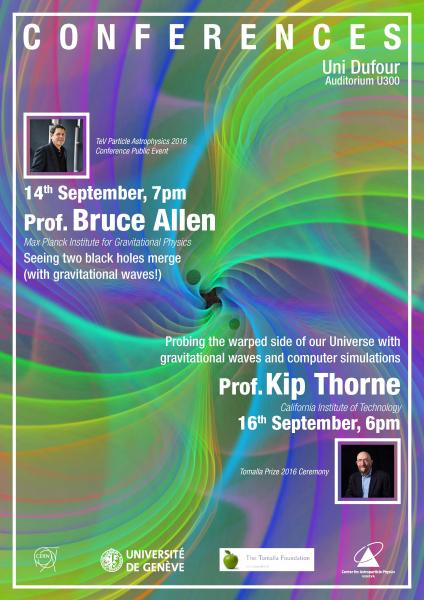In the frame of the TeV Particle Astrophysics 2016 conference week to be held at CERN on 12-16 September, eminents astrophysicians Prof. Bruce Allen and Prof. Kip Thorne will conduct two lectures on the most recent advances in the booming field of Astroparticle Physics.
No pre-booking is required, free entrance.
Wednesday, 14 September at 7 p.m.
"Seeing two black holes merge (with gravitational waves!)"
by Prof. Bruce Allen, Albert Einstein Institute Hannover
Uni Dufour - Auditorium U300
The first direct observation of gravitational waves from the inspiral and merger of two black holes.
On 14 September 2015, the advanced LIGO gravitational wave instruments detected the gravitational wave signal emitted as two black holes, about one billion light years away from Earth, made a final few orbits around each other then merged together. This was big news around the world, because scientists have tried to make such observations for more than half a century. Before they merged, the two black holes were about 29 and 36 times as massive as the sun; after the merger was complete, a single black hole about 62 times the sun's mass was left behind.
Prof. Allen will describe what black holes are, how they (and other accelerated masses) produce gravitational waves, and how those waves are detected. He will also discuss some of the behind-the-scenes details of this discovery, and why they are convinced that this signal, called GW150914, is real. For physics enthusiasts, Allen will explain how the main properties of the black holes can be directly determined from the observational data and also why they are convinced that no other explanation is possible.
Friday, 16 September at 6 p.m.
"Probing the warped side of our Universe with gravitational waves and computer simulations"
by Prof. Kip Thorne, recipient of the Tomalla Prize for Gravity 2016
Uni Dufour - Auditorium U300
A half century ago, John Wheeler challenged his students and colleagues to explore Geometrodynamics: the nonlinear dynamics of curved spacetime. How does the curvature of spacetime behave when roiled in a storm, like a storm at sea with crashing waves. We tried to explore this, and failed. Success eluded us until two new tools became available: computer simulations, and gravitational wave observations. Thorne will describe what these have begun to teach us, and he will offer a vision for the future of Geometrodynamics.
